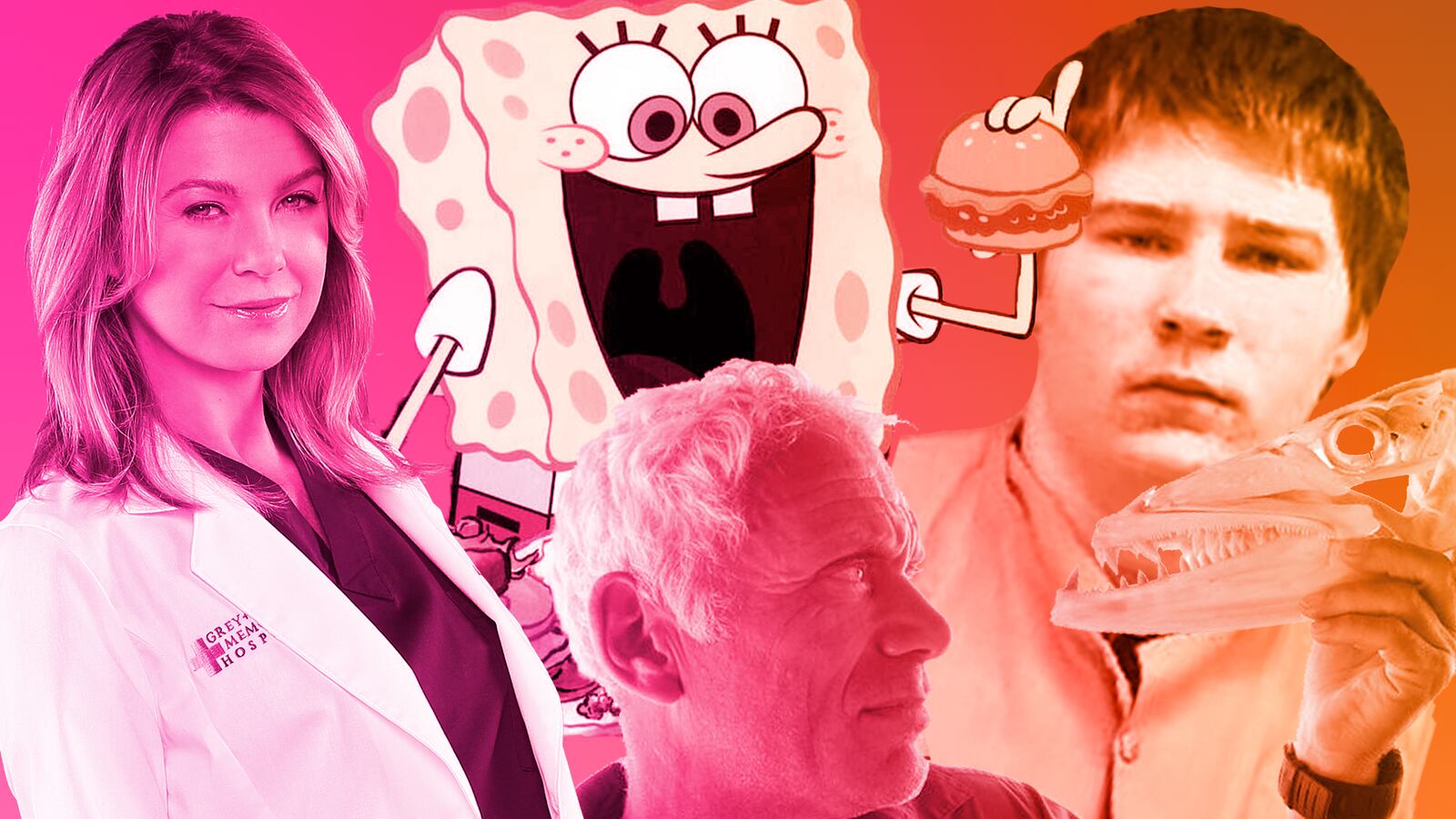Romance-killing true love franchises and nine seasons of Big Bang Theory aside, television can be genunely life-changing. It’s full of tempting life hacks, from sleeping with the POTUS, who is your boss (like in Scandal), to sleeping with a doctor, who is your boss (Grey's Anatomy), to shooting your boss (How to Get Away With Murder). Friends brainwashed a generation of women into thinking that “The Rachel” was universally flattering, and America’s Next Top Model tricked the entire world into believing that you can actually smile with your eyes.
But while we can all claim that television events such as Chad’s scorched-earth approach to Bachelor in Paradise or Simone Biles’s Olympic supremacy gave us life, few can say that TV literally saved their lives. And yes, we’re talking about the literal definition of literally, not Katrina Pierson’s.
Making a Murderer
Last week, Making a Murderer star Brendan Dassey became the latest subject capable of claiming that TV saved his life. Or Netflix, to be exact in his case. The then-17-year-old was convicted, along with his uncle Steven Avery, in the 2005 murder of Teresa Halbach. Brendan was a high school sophomore when he was first interrogated about the crime. He had a low I.Q. and was enrolled in special education classes. Making a Murderer portrays Dassey as an unconvincing criminal—intellectually challenged and often confused. One of the show’s most heart-wrenching moments shows the police asking a clearly befuddled Brendan a series of leading questions, essentially feeding him the “right” answers.
The show’s implicit indictment of the criminal justice system was partially redressed last week, when a federal judge in Milwaukee overturned Brendan Dassey’s conviction. According to court documents, the confession that led to Dassey’s life in prison sentence was obtained via “false promises.” The investigators’ shady interrogation, combined with “Dassey’s age, intellectual deficits, and the absence of a supportive adult,” led the judge to rule the confession “involuntary.” After almost a decade behind bars, Dassey will be released within 90 days, barring an appeal from the prosecution.
Scenes of a Crime
Back in 2014, Adrian Thomas experienced a remarkably similar reversal of fate. In 2009, Thomas was convicted of second-degree murder, sentenced to 25 years for allegedly killing his infant son. His story later became the subject of the award-winning Scenes of a Crime. The gripping documentary posited that Thomas’s 10-hour interrogation culminated in a false confession. Just two years later, the New York State Court of Appeals acquitted Thomas in a retrial, ruling that psychological pressure invalidated his confession. It’s safe to say that Scenes of a Crime garnered crucial legal support for the case, bringing Thomas’s story to the attention of a national audience as well as justice reform groups such as The Innocence Project and Center on Wrongful Convictions. Producer Grover Babcock offered a crucial caveat in the wake of the celebratory ruling, noting that “the Adrian Thomas case is far from unique. The only unique thing about Adrian Thomas’s case is that the process was richly documented.”
Curb Your Enthusiasm
In a slightly more comedic take on true crime, Larry David’s famously self-centered Curb Your Enthusiasm inadvertently acquitted a total stranger. Juan Catalan—who’s never actually seen David’s off-kilter comedy—spent 5½ months in jail on a false murder accusation. Prosecutors didn’t buy Catalan’s alibi; the father claimed that he was with his kids at Dodger Stadium on the night in question. Catalan’s attorney couldn’t find a clear match for his client on game footage. Luckily, Catalan later recalled an HBO TV crew filming nearby. That crew was collecting footage for the “Carpool Lane” episode of Curb Your Enthusiasm, which follows David’s attempt to get to a Dodgers game in time. Apparently, Catalan’s head had managed to make it into the corner of an outtake. The tapes, which were time coded, ultimately corroborated Catalan’s alibi, and a judge ordered his release.
House
But the falsely convicted aren’t the only ones who can claim television redemption. A cursory glance at the TV guide reveals a strange fascination with medicine and mortality, from hospital dramas to true-life tales. And while the educational value of shows like I Didn’t Know I Was Pregnant is debatable, this genre of emergency room TMI has remarkably led to some IRL diagnoses. In 2014, a German man with a mysterious condition was struggling to find a diagnosis. But when the 55-year-old approached a new doctor for a consultation, he emerged with answers after just five minutes. The heroic M.D., Dr. Juergen Schaefer, told reporters that he cracked the case by recalling an episode of House in which a fictional patient is plagued by a rare bout of cobalt poisoning. Apparently, there’s more to the beloved TV doctor’s method than just randomly crying lupus. Dr. Schaefer has actually written an entire book about how to apply the TV show to real life medical practice: It’s called Housemedizin: Die Diagnosen von “Dr. House,” which is fairly self-explanatory.
Grey’s Anatomy
Another patient, an Israeli mother-of-three, managed to diagnose herself thanks to everyone’s favorite hospital drama, Grey’s Anatomy. Apparently, Shonda Rhimes’s sudsy paean to sex in scrubs actually does have medical merit. When Sarit Fishbaine first felt an unusual lump on her breast, she was told by a doctor that it was likely milk. But after watching an episode of Grey’s in which a breastfeeding mother’s cancer is mistaken for milk, Fishbaine asked for a second opinion. When an urgent mammogram revealed cancer, Fishbaine was able to pursue early and aggressive treatment.
Save My Life: Boston Trauma
Rounding out this category is a miracle case courtesy of Save My Life: Boston Trauma, the unscripted ER-inspired series that many have called “hard to watch.” Seventy-one-year-old Dana Mower was just trying to distract himself from indigestion and heartburn with some channel surfing. But when he flipped to Save My Life and saw his symptoms onscreen, he began to wonder if he too was in the midst of a heart attack. Mower took himself to the emergency room, where his intuition was confirmed by the very same doctor whom he had been watching on TV the night before.
Bear Grylls and Survival TV
With the widespread popularity of wilderness survival shows, few among us haven’t wondered how we would fare in the great unknown. But a select number of unfortunate individuals have had the unique experience of watching castaway dreams turn into ant-eating realities. In 2013, a 17-year-old survived in the Sugarloaf Mountains for two days. When asked about his experience, the Massachusetts native attributed his survival tactics—like building a snow cave to stay warm—to watching survival TV shows. A few years later, a 62-year-old man was similarly stranded in the Australian outback. Reg Foggerdy’s impromptu episode of Man vs. Wild lasted for six painful days, after the grandfather got lost hunting a camel. With nothing but a dead camel and the T-shirt, shorts, and flip-flops off his back, Foggerdy turned to ants for nutrients—a trick he learned from watching British survival expert Bear Grylls. “They tasted quite good. The first day, I ate probably 12 ants—and the following day, I had 18,” Foggerdy said. He was eventually found and airlifted to safety.
River Monsters
But no freak occurrence speaks to the phenomenon of art imitating life quite like one castaway’s inadvertent rescue by a documentary TV program. Animal Planet’s River Monsters took a wilder-than-usual turn during a recent shoot, when the crew spotted a man stranded on a deserted island off the coast of Australia. The team had originally been covering the mystery of six men who died in a plane crash by the Gulf of Carpentaria. Naturally, they were distracted from their stated mission when a naked man emerged from a nearby cave, waving his arms about. The crew later estimated that the disoriented Aussie had been stranded without water and supplies for about 60 hours.
Hollyoaks
Among other lessons, these stories of serendipitous programming reveal that even the silliest TV shows can have serious consequences. A British woman reported that she discovered a carbon monoxide leak in her home thanks to a random poisoning subplot on teen saga Hollyoaks. Suffering from vomiting, headaches, drowsiness and aching eyes for 10 days—nothing a little binge-watching can’t fix—the 26-year-old happened upon an episode in which eight teens are almost killed by a faulty boiler. She then contacted gas company Transco, who discovered a defect in her gas fire allowing harmful fumes to escape.
Spongebob Squarepants and The Simpsons
An 8-year-old boy rescued his drowning 5-year-old neighbor by recalling a swimming stroke he had seen on SpongeBob SquarePants. Another cartoon enthusiast was able to save a pal from death-by-ham sandwich after seeing the Heimlich Maneuver performed on an episode of The Simpsons.
The X Factor
One last TV beneficiary is in a league of her own. After auditioning for the X Factor, Jacqui Gray was disappointed when Simon Cowell disparaged her “weird-sounding voice.” But with the unflappable confidence of a British William Hung, Gray refused to take the judge’s criticism as any sort of referendum on her vocal abilities. Instead, she went to see a throat specialist, who ended up diagnosing her with a potentially lethal lung infection. Despite her eternal gratitude for Simon Cowell’s recommendation, Gray remains insistent on subjecting him to another performance in the very near future, refusing to let her illness or her talent stop her from pursuing her singing ambitions.
This has been your weekly justification for prioritizing sitting on your couch and watching reruns over outdoor activities and human contact. Go forth and binge-watch!





